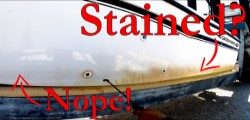Battery power is a baffling topic to most boaters, but is also critical for starting engines and running lights and accessories. If you don'’t happen to have an abundance of "smarts" when it comes to managing your charging needs, it helps to have a system with the "smarts" built-in. Fortunately, modern "smart" charging options are available to make proper care of batteries almost idiot-proof.
Marine deep-cycle batteries last the longest and charge the fastest if they are charged in distinct phases, which we refer to as the "Ideal Charge Curve", the charging schedule recommended by virtually all makers of marine batteries. In the description that follows, remember that recommending precise voltages for batteries is subject to at least two caveats:
- Gel batteries charge at different (and lower) voltages than flooded-type and AGM batteries
- The voltages stated are temperature-dependent
This makes it difficult to recommend precise charging voltages, since they vary according to the temperature of the battery. Most of us generally operate our boats in temperatures between 50°F and 90°F, and the values used in our West Advisors reflect that. Higher temperatures require lower voltages, and lower temperatures require higher voltages. Note: In the following section, we define the capacity of the battery bank (in amp-hours) as C.
The "Ideal Charge Curve"
Bulk Phase: This is where the heavy lifting takes place. Charge
at a rate up to 20%-40% of C to a voltage of about 14.4 volts (gel: 14.1V).
For example, a 200 amp-hour battery would be charged at 40-80 amperes. This
will bring the battery to about 75% of full charge, and is efficient (more amp-hours
per hour of charge time) since the battery accepts more current when it is discharged.
AGMs require slightly different voltages, and unless there is an AGM setting,
should be charged using lead-acid settings.
Acceptance Phase: Maintain battery at 14.4 volts (Gel: 14.1V) while the amperage is steadily reduced. This will restore the next 25% of capacity at a declining rate. Your battery can be considered fully charged if it will accept current equal to 2% of C at 14.4 volts (a 200 amp-hour battery will only accept 4 amps).
Float Phase: When the battery’s acceptance declines to 2-4% of C, the voltage is reduced to 13.3 volts (Gel: 13.1V) to maintain the battery without losing electrolyte from the cells. This is a maintenance phase, not a charging phase.
Equalization: This stage is used to prevent flooded lead acid batteries from aging prematurely, and is an optional, but frequently omitted phase. After the battery reaches the end of the acceptance phase, the battery continues to be charged at 4% of C until the voltage stops rising, usually around 15.5-16.2 volts. This forces the battery to its highest possible state of charge, boiling the electrolyte in a controlled manner and dissolving the crystals of lead sulfate that have collected on the battery's plates. In industrial applications where maximum energy storage is important, this phase is done every charge cycle. In the marine environment, it is more likely to be done every 20-50 cycles to extend the life and capacity of wet batteries. Gel and AGM batteries should not be equalized. Since electrical equipment and light bulbs can be damaged by high voltage, the battery should be disconnected from all loads during equalization.
This type of battery charging, consisting of multiple stages, is not possible with automotive-type alternator regulators, unregulated solar panels, ferroresonant chargers, or taffrail generators. We strongly encourage the use of efficient charge devices, both for shorepower charging and alternator regulation, that use modern multiple-step regulation.
What size of charger do I need?
Deciding how big your charger needs to be is determined by the size and type
of your batteries, and whether your boat has a continuous or intermittent source
of AC power to run your charger. Boats that spend most of their week at a dock,
constantly hooked up to shore power, require smaller chargers. You need enough
capacity to run the continuous loads on your battery system, like DC refrigeration
(frequently the biggest user of battery power) and lights, plus enough power
to float-charge your batteries. A good rule is to have enough amperage to equal
the sum of the DC loads plus 10% of the amp-hour capacity of the batteries.
If you're cruising or anchored out, and aren't plugged in except intermittently, you will want enough capacity to recharge in the time you have available, if possible. You need enough juice to replace the power consumed by all the DC loads, as above, plus an average charge rate equaling the amp hours required divided by the hours available. Maximum amperage that batteries can accept during the Bulk Phase of the charging cycle vary depending on battery chemistry: flooded batteries can accept a charge rate of up to 25% of C; gel batteries have a higher acceptance rate of as much as 30%; AGM batteries accept the highest charging amps, as much as 40% of C.
How long does it take to charge?
If you operate your house bank between a 50% and 85% state of charge, as many
experts recommend, and charge once daily, you should be able to return the 35%
of battery capacity by operating a properly-sized alternator for slightly over
an hour. More deeply discharged batteries, or smaller alternators, will require
more time.
Surprisingly, using a massive charger or monster alternator to pour on the current can be counterproductive, and can shorten your battery life. Excessive current makes batteries heat up and gas excessively (when the electrolyte dissociates into hydrogen and oxygen). Soon the voltage limit is reached, causing a downshift from the Bulk to Acceptance Phase. Adding more battery capacity is a better solution, and may even decrease the needed recharging time. Bigger battery banks can accept more charging amps, so they replenish more quickly and you don’t need to run your engine as long.
Tips for battery longevity
- Shallow discharges lead to a longer battery life
- 80% discharge is the maximum safe discharge
- Don't leave batteries deeply discharged for any length of time
- Charge batteries after each period of use
- Don't mix old batteries with new ones
How to kill a Battery
Undercharging: consistently failing to fully recharge batteries leaves them with lead sulfate that hardens on their plates–they become sulfated–and gradually lose their ability to perform. Increased resistance when charging causes falsely elevated voltage readings, essentially fooling the battery charger, leading to further undercharging, in a downward spiral. Beyond a certain point, a sulfated battery cannot be returned to a healthy state, and you need a replacement. Keep your batteries charged, and equalize your wet cell batteries every six to eight weeks in temperate climates, and more frequently in the tropics.
Overcharging: Especially fatal to Gel and AGM batteries, consistent overcharging (NOT equalization) boils the electrolyte out of the cells, and can even lead to thermal runaway, with the battery becoming hotter and hotter.
Excessive deep discharge: Don't completely discharge a deep cycle battery if it can be avoided. The deeper the discharge the less life you will get from the battery. The ideal method is to charge and discharge the batteries through the middle range (50% – 85%) of their capacity and, if they are flooded batteries, to equalize them periodically. Leaving the battery in a fully-discharged state, for example during winter storage, causes it to become sulfated.













































